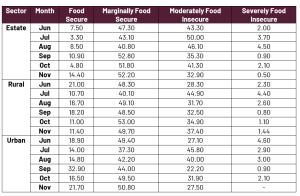Fact Check
The MP in his statement effectively makes two claims on the gap between the estate sector and the rest of the country: (1) that poverty is almost double, and (2) that food insecurity in the estate sector is between 20% and 30% more in the estate sector than in urban and rural sectors.
Claim 1: The MP seems to draw from World Bank (WB) Sri Lanka Development Update October 2022 edition, for this claim.
The WB projections, based on microsimulations, estimate the poverty rate as having increased to 25.6% in 2022 (it was estimated at 13.1% in 2021). Disaggregated estimates have the poverty rate in the estate sector as 53.7% (See Exhibit 1). These figures are in line with the numbers and argument presented by the MP. (See additional note for more details on the WB poverty estimate).
Claim 2: The MP seems to draw from the World Food Programme (WFP) Sri Lanka Food Security Monitoring Face-to-Face Food Security Survey Briefs, for this claim.
There are two categories of food insecurity: 1) moderately food insecure, and 2) severely food insecure. The WFP survey data that was published at the time the MP made his statement was for August 2022. There the estimated level of total food insecurity (addition of the two categories) was 50.6% for estate, 43% for urban, and 34.3% for rural. These figures align with the numbers quoted by the MP. (See Exhibit 2).
The MP’s claims on the higher rates of poverty, and food-security in the estate sector are correct – based on the best estimates available from the only sources that had formal disaggregated estimates, at that time. See additional note for how the food security dynamics have changed since.
Therefore, we classify his statement as TRUE.
*FactCheck.lk’s verdict is based on the most recent information that is publicly accessible. As with every fact check, if new information becomes available, FactCheck.lk will revisit the assessment.
Exhibit 1 – Poverty Rates in Sri Lanka 2019 – 2022 
Source: The World Bank Sri Lanka Development Update
Exhibit 2 – Food insecurity in Sri Lanka June to November 2022

Source: World Food Programme Sri Lanka Food Security Monitoring
Additional Note
The WB classifies those earning less than USD 3.65 per capita per day in purchasing power parity [PPP] terms in 2017 in lower middle-income countries as being in poverty. This is a different method of estimation from the poverty line based on the consumption of a specific basket of goods, calculated by the Department of Census and Statistics (DCS). The WB poverty line was equal to LKR 5,408.21 per capita per month based on the PPP conversion factor published by the WB in 2017. An approximate adjustment of that based on exchange rates in October 2022, assuming no change in the PPP ratio, gives a poverty line of LKR 12,883. The official poverty line, used by DCS based on consumption patterns derived from the 2012/13 Household Income and Expenditure Survey and adjusted for prices in October 2022 is LKR 13,810. On food security, the latest available surveys of WFP (at the time of publishing this fact check) are for November 2022, and are: 33.4% for estate, 27.5% for urban, and 38.8% for rural. That means, food insecurity in the rural sector has overtaken food insecurity in the estate sector. Therefore, as of November 2022, the food insecurity situation no longer aligns with the MP’s claim.
Sources
Sri Lanka Development Update – Protecting the Poor and Vulnerable in a Time of Crisis, The International Bank for Reconstruction and Development and The World Bank, October 2022, Available at; https://thedocs.worldbank.org/en/doc/6c87e47ca3f08a4b13e67f79aec8fa3b-0310062022/original/Sri-Lanka-Development-Update-October-2022-final.pdf [Last accessed 10 January 2023]
Sri Lanka Food Security Monitoring Face-to-face Food Security Survey Brief November 2022, World Food Programme, Available at; https://docs.wfp.org/api/documents/WFP-0000145643/download/?_ga=2.23857786.1323882724.1673345503-602456413.1669350556 [Last accessed 10 January 2023]
Technical Guidance for WFP Consolidated Approach for Reporting Indicators of Food Security (CARI) Third Edition December 2021, World Food Programme, Available at; https://docs.wfp.org/api/documents/WFP-0000134704/download/#:~:text=The%20CARI%20assesses%20availability%20and,vulnerability%20and%20livelihood%20coping%20strategies [Last accessed 10 January 2023]
Special Report: FAO/WFP Crop and Food Security Assessment Mission (CFSAM) to the Democratic Socialist Republic of Sri Lanka (September 2022), Food and Agriculture Organization of the United Nations and World Food Programme, Available at; https://reliefweb.int/report/sri-lanka/special-report-faowfp-crop-and-food-security-assessment-mission-cfsam-democratic-socialist-republic-sri-lanka-september-2022 [Last accessed 10 January 2023]
PPP conversion factor, GDP (LCU per international $) – Sri Lanka, Available at; https://data.worldbank.org/indicator/PA.NUS.PPP?locations=LK [Last accessed 10 January 2023]
Official poverty line by District, Department of Census and Statistics, Available at; http://www.statistics.gov.lk/povertyLine/2022_new[Last accessed 10 January 2023]
Monthly Economic Indicators, Central Bank of Sri Lanka, October 2022, Available at; https://www.cbsl.gov.lk/sites/default/files/cbslweb_documents/statistics/mei/MEI_202210_e.pdf[Last accessed 10 January 2023]


